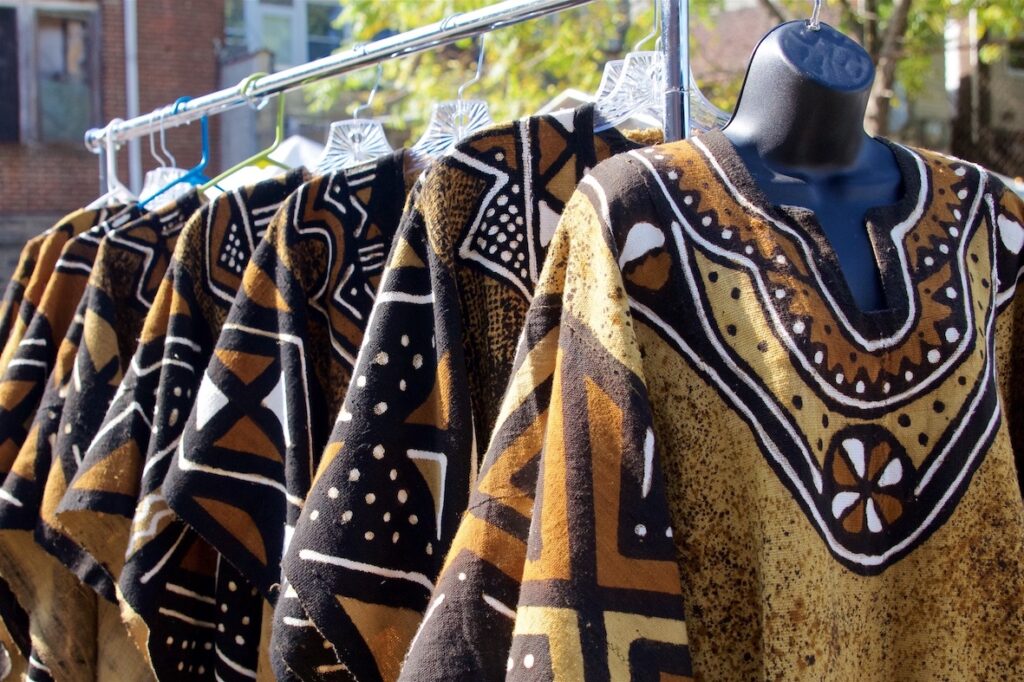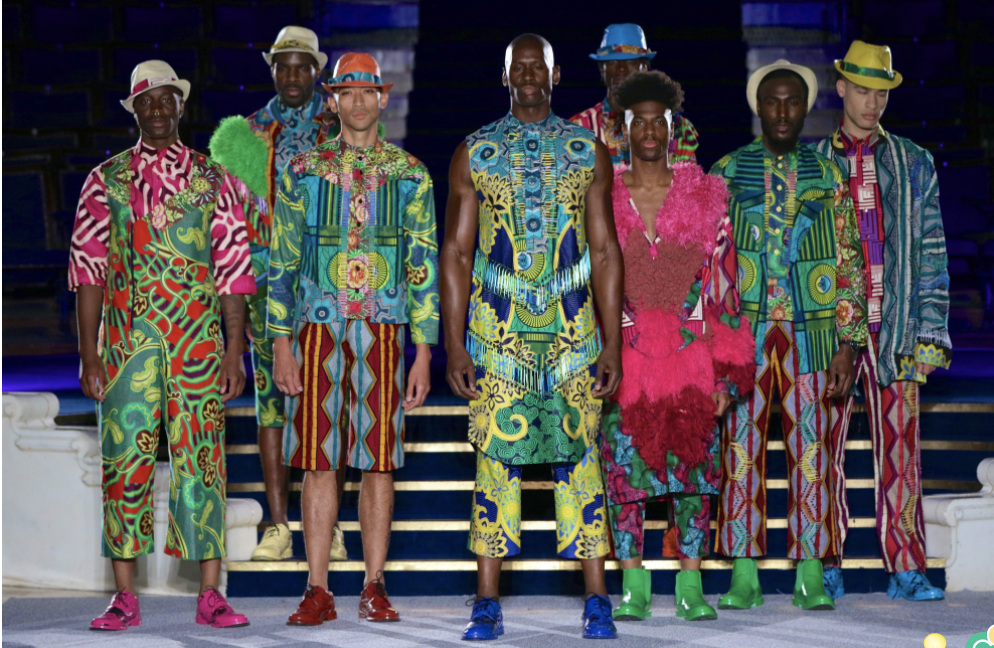Fashion: Types of African Cloth and their symbolism. Wear it with pride, because it’s stitched with history

African clothing is known for its colourful fabrics and distinctive designs. But few people take the time to examine the cultural significance of African cloth. This is a fascinating history that should make you beam with pride next time you don that African outfit.
The presence of textiles in the African world dates back to Phoenician times. At various times in history, migration and integration have spread African textiles to different regions of Africa and the world. The colourful clothes of Africa first became a sign of wealth around 1000BC, during the period of the trans-Saharan trade when traders used strip cloth as a form of currency.
The presence of textiles in the African world dates back to Phoenician times. At various times in history, migration and integration have spread African textiles to different regions of Africa and the world. The colourful clothes of Africa first became a sign of wealth around 1000BC, during the period of the trans-Saharan trade when traders used strip cloth as a form of currency.
As a result, African textiles became known worldwide. During the European coastal trade in the 1400s, African fabrics were preferred by traders over European fabrics. Traders used African cloth in the triangular trade of the 17th and 19th centuries. The development of trade with the world established a ruling class in Africa, which in turn developed a need for luxury items. The quality and colour of African textiles became an expression of wealth and knowledge in society and an indication of social hierarchy. For example, the development of kente cloth in the Ashanti (Ghana) illustrates how the use of cloth differentiates people by status – fine kente cloth symbolises leadership.
Types of African Cloth and their symbolism

In order of tradition and value, weaves, tie-dyes, batiks and industrial prints represent the four types of cloth Africans use to create clothing. Weaving represents a tradition that passed down from father to son, from uncle to nephew, from mother to daughter and from aunt to niece. The complexity of the weave, the colour, and the type of thread used determines the value of the fabric.
The use of locally spun threads enhances the value of the cloth, as such, [some] Africans believe that imported textiles have no ancestral link and therefore of less value.
Bogolanfini, aso oke, kuba raffia and kente offer examples of woven cloth.
Bogolanfini, also known as mud cloth, is the traditional cloth from the countryside north of the Malian capital, Bamako. With rich blacks, browns, and whites, sections of cloths are composed of individual motifs or a combination of motifs such as fish bones, little stars, or squares.
Aso oke, a traditional cloth of the Yoruba, has three main designs: etu, a dark blue indigo-dyed cloth (a verse from an Ifa divination text describes it as the “father of all cloths”); sanyan, a brown cloth woven from the beige silk of the Anaphe moth; and alaari, woven from silk obtained from the Sahara. For the Yoruba, cloth made completely of silk is rare. Strips of silk cloth are commonly used as decoration for indigo-dyed cloth.
Kuba raffia, the traditional cloth of the Kuba people of the Democratic Republic of Congo, remains an example of a tradition of raffia weaving that was once widespread throughout central Africa.
Kente, probably the best-known of African fabrics, is proudly worn by ruling politicians and high-ranking officials in Ghana. A colourful fabric of golds, yellows, reds, blacks, greens and blues, each intricately designed piece of fabric is a functional object that conveys messages about historical and cultural landmarks, philosophical concepts, political thoughts, or the religious and moral values of society. All the above-mentioned are examples of woven cloths.
But there are others, such as indigo cloth in tie-dye and batiks, which are cotton fabrics with designs painted on them using a wax technique. Batiks and wax prints are more commonly used today in the creation of African clothing. Africans use them not just for everyday wear, but also for creating clothes for special ceremonies and events. The quality of the fabric and the complexity of the design also differentiate everyday wear from formal wear.
The meaning of colour

Colours in African cloth are of very important meaning which vary from people to people and cloth to cloth.
For example, the Akan people in West Africa use dark colours such as red, black, and brown for funerals; the Akon use white for joyous occasions, such as naming ceremonies. In kente cloth, gold represents status and serenity. Yellow represents fertility (like the ripeness of an egg yolk or a fruit) and vitality. Green signifies the renewal and growth seen in plants, and represents the cycle of birth and decay. Blue represents the presence of God and the omnipotence of the blue sky. Blue also refers to a pure spirit, one which rests in harmony. Red connotes passion – the passion of political determination, struggle, and defence. The Ashanti also believe that red holds protective powers. Black denotes seriousness, union with ancestors and implies spiritual awareness.
Of course, at some point, fabric becomes clothing. Indeed, clothing traditions vary with each African ethnic group. Each society has its own name for different types of clothing made out of traditional cloth particular to that group of people. However, one finds similarities across cultures. And with migration and interaction over time, ethnic groups have adapted and share customs of dress.
Its also about style

Styles of clothing vary from the simple, plain shirt and wrap to the intermediate, in which there is the beginning of design and slight detail and to complex, more detailed, formal cloths. Different ethnic groups have their own names for a particular piece of clothing. For example, the Hausa call a top – riga, a bottom – wando, and a gown – buba riga, while the Yoroba call a top – buba, a bottom – sokoto, and a gown -agbada.
Traditional use of the cloths also differs from one group to another. The Mende people in Sierra Leone, for example, use country cloth for various ceremonial purposes including marriage gifts, burials, religious purposes, and gifts for visitors.
In courtship, the groom or his relatives gives traditional cloth to the family of the bride as a gift. In burial ceremonies, the gathering of traditional cloth helps to denote the kind of afterlife one will lead. Those who bury the dead must dress the deceased in white hand-spun threads and place traditional cloth next to the body or at the bottom of the grave. Dressing the individual in white also represents Muslim influence.
Traditionally, some cloths such as kente were used only by people of certain status or for particular ceremonies. Today, the Ashanti wear kente cloth outside of court regalia. Men wear Kente by wrapping a piece of cloth (on average 8 feet wide by 12 feet long) around themselves, leaving the right shoulder and hand uncovered. Women wear it wrapped around their body, with or without a match a matching blouse.
With the advent of modern fashion, aso oke, which was commonly worn by the Yoruba, is now worn during events such as naming ceremonies, engagements, weddings, and funerals, as well as religious ceremonies.
West meets Africa
African fashion has influenced, and has been influenced by other cultures. Post-Renaissance Europe greatly admired the raffia of Central Africa and it found its way into European treasuries along with other creations of African art. Raffia designs were a source of inspiration to Matisse, the famous French painter, who hung a large part of the design on the wall of his studio.
Different styles of African fashion have evolved from a mixture of African and Western cultures. There are many clothes of traditional African cut which are fashioned using a combination of Western and African cloth. African designers create clothes of Western design using traditional African cloth. Hence today you can find kente ties and dies, or coats made from indigo cloth. One might see a sora (a woman’s wrap skirt), made from jean material with accents of bogolanfini (mud cloth), and many other examples.
Today, African dress and cloth influences fashion throughout the world – from New York, Milan to London. African fashion and traditional styles have been adopted and adapted by Africans of the Diaspora and even non Africans who are increasingly wearing bubus, soras, geles and kentes. Many European cities now celebrate African culture and traditional African dress another illustration of the dynamic nature of African fashion.
*From our archives: This article was first published in Issue 1 of New African Woman print edition.









